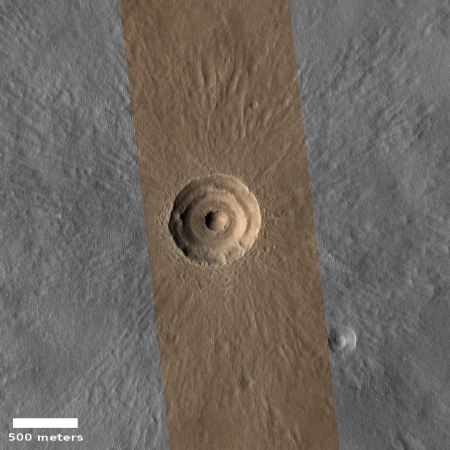A bullseye on Mars
Cool image time! The photo on the right, cropped and reduced to post here, was taken by the high resolution camera of Mars Reconnaissance Orbiter (MRO) on November 30, 2019. It shows a lone crater on the flat northern lowlands of Mars in a region dubbed Arcadia Planitia.
The crater is intriguing because of its concentric ridges and central pit. As this region is known to have a great deal of subsurface water ice, close to the surface, these features were probably caused at impact. My guess is that the ice quickly melted, formed the kind circular ripples you see when you toss a pebble in a pond, but then quickly refroze again, in place.
This location is also of interest in that is it just north of the region that SpaceX considers the prime candidate landing site for its Starship manned spaceship.
On Christmas Eve 1968 three Americans became the first humans to visit another world. What they did to celebrate was unexpected and profound, and will be remembered throughout all human history. Genesis: the Story of Apollo 8, Robert Zimmerman's classic history of humanity's first journey to another world, tells that story, and it is now available as both an ebook and an audiobook, both with a foreword by Valerie Anders and a new introduction by Robert Zimmerman.
The print edition can be purchased at Amazon or from any other book seller. If you want an autographed copy the price is $60 for the hardback and $45 for the paperback, plus $8 shipping for each. Go here for purchasing details. The ebook is available everywhere for $5.99 (before discount) at amazon, or direct from my ebook publisher, ebookit. If you buy it from ebookit you don't support the big tech companies and the author gets a bigger cut much sooner.
The audiobook is also available at all these vendors, and is also free with a 30-day trial membership to Audible.
"Not simply about one mission, [Genesis] is also the history of America's quest for the moon... Zimmerman has done a masterful job of tying disparate events together into a solid account of one of America's greatest human triumphs."--San Antonio Express-News
Cool image time! The photo on the right, cropped and reduced to post here, was taken by the high resolution camera of Mars Reconnaissance Orbiter (MRO) on November 30, 2019. It shows a lone crater on the flat northern lowlands of Mars in a region dubbed Arcadia Planitia.
The crater is intriguing because of its concentric ridges and central pit. As this region is known to have a great deal of subsurface water ice, close to the surface, these features were probably caused at impact. My guess is that the ice quickly melted, formed the kind circular ripples you see when you toss a pebble in a pond, but then quickly refroze again, in place.
This location is also of interest in that is it just north of the region that SpaceX considers the prime candidate landing site for its Starship manned spaceship.
On Christmas Eve 1968 three Americans became the first humans to visit another world. What they did to celebrate was unexpected and profound, and will be remembered throughout all human history. Genesis: the Story of Apollo 8, Robert Zimmerman's classic history of humanity's first journey to another world, tells that story, and it is now available as both an ebook and an audiobook, both with a foreword by Valerie Anders and a new introduction by Robert Zimmerman.
The print edition can be purchased at Amazon or from any other book seller. If you want an autographed copy the price is $60 for the hardback and $45 for the paperback, plus $8 shipping for each. Go here for purchasing details. The ebook is available everywhere for $5.99 (before discount) at amazon, or direct from my ebook publisher, ebookit. If you buy it from ebookit you don't support the big tech companies and the author gets a bigger cut much sooner.
The audiobook is also available at all these vendors, and is also free with a 30-day trial membership to Audible.
"Not simply about one mission, [Genesis] is also the history of America's quest for the moon... Zimmerman has done a masterful job of tying disparate events together into a solid account of one of America's greatest human triumphs."--San Antonio Express-News



Molten rock rose post strike, then solidified into a hill or mountain, not a pit nor crater.
If you take the extra time to notice which direction the light comes from (Right hand) by the surrounding splatter lines their shadows, it is apparent to me the so described crater is actually a rise compared to surrounding elevations. It is even more fascinating this way, fwiw.
As you say, the lack of atmosphere aided in freezing (if you will) the molten matter into place- a mountain of concentric circles.
If may help visualize my assessment if you imagine a drop of water falling into a cup of water, at one point, the water makes concentric circles higher than the level of the cup of water. The speedy cooling from lack of atmosphere aided in solidifying the matter before its wet-state equalized with the surrounds.
All this said, one does presume an non retouched image.
good stuff.